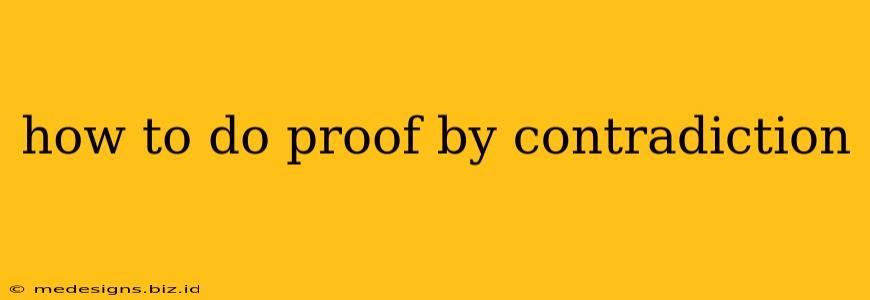Proof by contradiction, also known as reductio ad absurdum, is a powerful and elegant method of mathematical proof. It's used to prove a statement by showing that assuming the opposite of the statement leads to a contradiction. This contradiction demonstrates that the original assumption must be false, thereby proving the original statement to be true. Mastering this technique can significantly enhance your mathematical reasoning skills.
Understanding the Core Principle
The fundamental idea behind proof by contradiction hinges on the law of excluded middle. This law states that for any statement P, either P is true or its negation (¬P) is true; there's no third option. In a proof by contradiction, we assume the negation of the statement we want to prove (¬P) and then deduce a contradiction. Since a contradiction cannot be true, our initial assumption (¬P) must be false, which directly implies that the original statement (P) is true.
Steps to Construct a Proof by Contradiction
Let's break down the process into manageable steps:
-
Clearly State the Proposition: Begin by explicitly stating the proposition (P) you aim to prove. This provides a clear target and ensures you remain focused throughout the proof.
-
Assume the Negation: State the negation (¬P) of the proposition as your assumption. This is the crucial first step in the method. Be precise in formulating the negation; a poorly stated negation can invalidate the entire proof.
-
Deduce Consequences: From the assumed negation (¬P), logically deduce a series of consequences. Use established theorems, axioms, and definitions to derive these consequences. Your goal is to reach a contradiction.
-
Identify the Contradiction: The key is to arrive at a statement that contradicts a known truth, a previously established fact, the initial assumption (¬P), or the proposition itself (P). Contradictions can take various forms, such as:
- A statement that is both true and false: For example, showing that x = 2 and x = 3 simultaneously.
- A violation of a previously proven theorem: Showing that a result contradicts a fundamental theorem or axiom.
- A self-contradictory statement: For example, proving that a number is both even and odd.
-
Conclude the Proof: Once you've identified the contradiction, explicitly state that the initial assumption (¬P) must be false. Therefore, the original proposition (P) must be true. This completes the proof by contradiction.
Example: Proving the Irrationality of √2
Let's illustrate the method with a classic example: proving that the square root of 2 (√2) is irrational.
1. Proposition (P): √2 is irrational.
2. Assumption (¬P): Assume √2 is rational. This means it can be expressed as a fraction a/b, where a and b are integers, b ≠ 0, and a and b have no common factors (the fraction is in its simplest form).
3. Deduce Consequences: * If √2 = a/b, then squaring both sides gives 2 = a²/b². * Rearranging, we get 2b² = a². * This implies that a² is an even number (since it's equal to 2 times another integer). * If a² is even, then a must also be even (because the square of an odd number is always odd). * Since a is even, we can write a = 2k for some integer k. * Substituting a = 2k into 2b² = a², we get 2b² = (2k)² = 4k². * Dividing by 2, we have b² = 2k². * This implies that b² is also even, and therefore b must be even.
4. Identify the Contradiction: We've shown that both a and b are even. However, this contradicts our initial assumption that a/b is in its simplest form (no common factors). If both a and b are even, they share a common factor of 2.
5. Conclusion: Since our assumption that √2 is rational leads to a contradiction, the assumption must be false. Therefore, √2 is irrational.
Tips for Success
- Practice: The best way to master proof by contradiction is through practice. Work through numerous examples to develop your intuition and problem-solving skills.
- Careful Notation: Use clear and precise notation to avoid ambiguity and errors.
- Step-by-Step Approach: Break down complex problems into smaller, manageable steps.
- Review Your Logic: After completing a proof, carefully review each step to ensure the logical flow is sound and free of errors.
Proof by contradiction is a valuable tool in your mathematical arsenal. By understanding its principles and practicing its application, you'll significantly enhance your ability to prove mathematical statements and deepen your understanding of mathematical reasoning.
